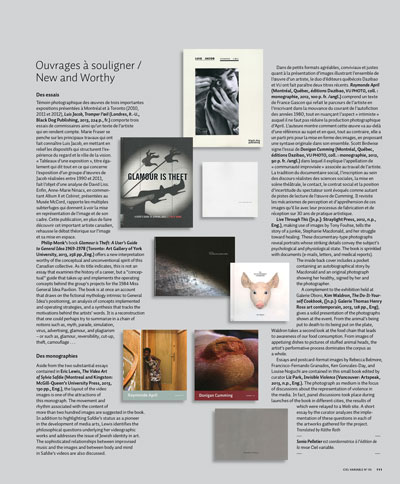
CV95 – CYBER / ESPACE / PUBLIC // Ouvrages à souligner
Par Sonia Pelletier
Des essais
Témoin photographique des oeuvres de trois importantes expositions présentées à Montréal et à Toronto (2010, 2011 et 2012), Luis Jacob, Tromper l’oeil (Londres, R.-U., Black Dog Publishing, 2013, 224 p., fr.) comporte trois essais de commissaires ainsi qu’un texte de l’artiste qui en rendent compte. Marie Fraser se penche sur les principaux travaux qui ont fait connaître Luis Jacob, en mettant en relief les dispositifs qui structurent l’expérience du regard et le rôle de la vision. « Tableaux d’une exposition », titre également qui dit tout en ce qui concerne l’exposition d’un groupe d’oeuvres de Jacob réalisées entre 1990 et 2011, fait l’objet d’une analyse de David Liss. Enfin, Anne-Marie Ninacs, en commentant Album X et Cabinet, présentées au Musée McCord, rapporte les multiples subterfuges qui donnent à voir la mise en représentation de l’image et de son cadre. Cette publication, en plus de faire découvrir cet important artiste canadien, rehausse le débat théorique sur l’image et sa mise en espace.
Philip Monk’s book Glamour is Theft: A User’s Guide to General Idea 1969-1978 (Toronto: Art Gallery of York University, 2013, 256 pp.,Eng.) offers a new interpretation worthy of the conceptual and unconventional spirit of this Canadian collective. As its title indicates, this is not an essay that examines the history of a career, but a “conceptual” guide that takes up and implements the operating concepts behind the group’s projects for the 1984 Miss General Idea Pavilion. The book is at once an account that draws on the fictional mythology intrinsic to General Idea’s positioning, an analysis of concepts implemented and operating strategies, and a synthesis that tracks the motivations behind the artists’ words. It is a reconstruction that one could perhaps try to summarize in a chain of notions such as, myth, parade, simulation, virus, advertising, glamour, and plagiarism – or such as, glamour, reversibility, cut-up, theft, camouflage . . .
Des monographies
Aside from the two substantial essays contained in Eric Lewis, The Video Art of Sylvia Safdie (Montreal and Kingston: McGill-Queen’s University Press, 2013, 130 pp., Eng.), the layout of the video images is one of the attractions of this monograph. The movement and rhythm associated with the content of more than two hundred images are suggested in the book. In addition to highlighting Safdie’s status as a pioneer in the development of media arts, Lewis identifies the philosophical questions underlying her videographic works and addresses the issue of Jewish identity in art. The sophisticated relationships between improvised music and the images and between body and mind in Safdie’s videos are also discussed.
Dans de petits formats agréables, conviviaux et justes quant à la présentation d’images illustrant l’ensemble de l’oeuvre d’un artiste, le duo d’éditeurs québécois Dazibao et VU ont fait paraître deux titres récents. Raymonde April (Montréal, Québec, éditions Dazibao, VU PHOTO, coll. : monographie, 2012, 100 p. fr. /angl.) comprend un texte de France Gascon qui refait le parcours de l’artiste en l’inscrivant dans la mouvance du courant de l’autofiction des années 1980, tout en nuançant l’aspect « intimiste » auquel il ne faut pas réduire la production photographique d’April. L’auteure montre comment cette oeuvre va au-delà d’une référence au sujet et en quoi, tout au contraire, elle a un parti pris pour la mise en forme des images, en proposant une syntaxe originale dans son ensemble. Scott Birdwise signe l’essai de Donigan Cumming (Montréal, Québec, éditions Dazibao, VU PHOTO, coll. : monographie, 2012, 90 p. fr. /angl.) dans lequel il explique l’appellation de « communauté improvisée » associée au travail de l’artiste. La tradition du documentaire social, l’inscription au sein des discours réalistes des sciences sociales, la mise en scène théâtrale, le contact, le contrat social et la position d’incertitude du spectateur sont évoqués comme autant de pistes de lecture de l’oeuvre de Cumming. Il revisite les mécanismes de perception et d’appréhension de ces images qu’il lie avec leur processus de fabrication et de réception sur 30 ans de pratique artistique.
Live Through This ([n.p.]: Straylight Press, 2012, n.p., Eng.), making use of images by Tony Fouhse, tells the story of a junkie, Stephanie Macdonald, and her struggle toward healing. These documentary-type photographs reveal portraits whose striking details convey the subject’s psychological and physiological state. The book is sprinkled with documents (e-mails, letters, and medical reports). The inside back cover includes a pocket containing an autobiographical story by Macdonald and an original photograph showing her healthy, signed by her and the photographer.
A complement to the exhibition held at Galerie Oboro, Kim Waldron, The Do-It-Yourself Cookbook, ([n.p.]: Galerie Thomas Henry Ross art contemporain, 2013, 128 pp., Eng), gives a solid presentation of the photographs shown at the event. From the animal’s being put to death to its being put on the plate, Waldron takes a second look at the food chain that leads to awareness of our food consumption. From images of appetizing dishes to pictures of stuffed animal heads, the artist’s performative process dominates the corpus as a whole.
Essays and postcard-format images by Rebecca Belmore, Francisco-Fernando Granados, Ken Gonzales-Day, and Louise Noguchi are contained in this small book edited by curator Liz Park, Invisible Violence (Vancouver: Artspeak, 2013, n.p., Eng.). The photograph as medium is the focus of discussions about the representation of violence in the media. In fact, panel discussions took place during launches of the book in different cities, the results of which were relayed to a Web site. A short essay by the curator analyzes the implementation of these questions in each of the artworks gathered for the project.
Translated by Käthe Roth
Sonia Pelletier est coordonnatrice à l’édition de la revue Ciel variable.
